#gintama spoiler
Text
Gintama’s really got something for everyone.
The anime’s funny and has this energy to it that you can tell everyone involved was having a great time. It’s a wonderful ensemble comedy that genuinely makes me laugh out loud.
The serious arcs are hype as heck, the fights are brutal and well choreographed. And they exist to magnify the emotional beats, so they feel like they have narrative weight. It matters how a fight goes down.
It’s a very good political drama. From the beginning you can tell that something shifty is going on, and each group is more or less its own political faction. The plotting is tight and it’s easy to follow what each faction wants and why.
And it has really a great philosophical message. It has something to say, and that message is bigger than all the individual moments of self reflection from the cast. The narrative feels subtly woven together to make that greater message.
And it’s anime comfort food. It’s found family. It’s learning to live and make connections to other people even though it’s hard.
It’s a series that’s big enough that you could live in it.
192 notes
·
View notes
Text
By Gintama standards, this just made them official


#sctir#sctir spoilers#my s-class hunters#the s-classes that i raised#sung hyunjae#tsctir#han yoojin#s classes that i raised#change my mind#but gently#i'll cry#hijigin#gintoki#hijikata#gintama#hijikata x gintoki#gintoki x hijikata
507 notes
·
View notes
Text
'wtf is gintama about' well if you listen to me (non intellectual) i'll tell you it's mostly about suicide but if you listen to some tumblrinas (intellectuals) they'll tell you it's about anal sex and if you look at it in terms of the grand scale of the plot it's about a guy with disassociative identity disorder trying to kill himself and getting thwarted by a magic dog. but actually it's about the opening of japan to foreign interests in the 1860s
368 notes
·
View notes
Text
Gintama Parallels "I had enough of your crying face"

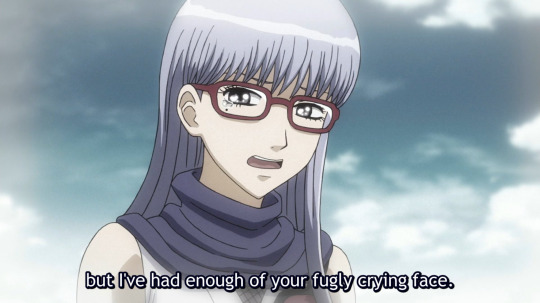

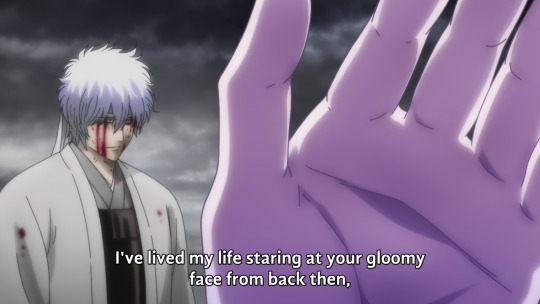

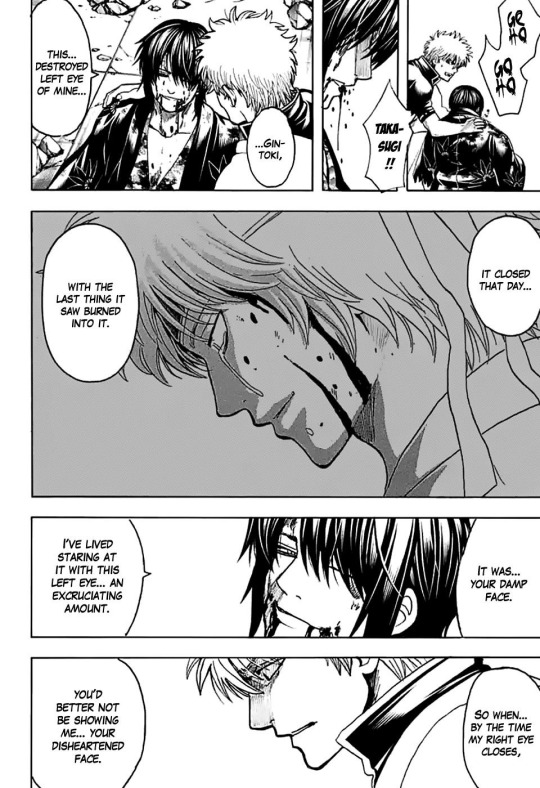


#gintama spoilers#takagin#kyutae#zensachi#gintaka#sakata gintoki#takasugi shinsuke#gintama#sarutobi ayame#hattori zenzou#yagyuu kyuubei#shimura otae#they are so...
176 notes
·
View notes
Text

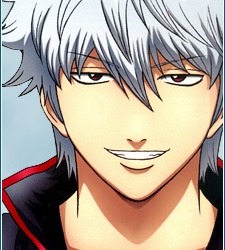
#hiromi higuruma#jujutsu kaisen#jjk#sakata gintoki#gintoki sakata#gintama#jjk spoilers#jujutsu kaisen spoilers#Spoiler poll#anime#anime poll#polls#whoishotteranimepolls
36 notes
·
View notes
Text

A quick drawing of the siblings who broke my heart </3
#gintama#okita mitsuba#okita sougo#maybe I drew Sougo too small#and Mitsuba's arms kinda strange looking#but it's finneeee#(I really need to pick up an anatomy book sometime)#gintama fanart#gintama spoilers#?
33 notes
·
View notes
Note
What your favorite ginzura moments :D
"I'll be your left arm"
"Zura wouldn't let himself get killed by someone like you"
End of Benizakura arc
Them turning ooold together. "Hey, Zura? Can you still stand up straight?"
Ramen arc, especially Gintoki saying Katsura is too good to fight the bad guy, and the ending
"Gintoki... Let's meet at dawn"
"Let's make rice cakes together!"
"I'll be your general, so when you're with me, just be Zura"
Katsura turning aeay to hide tears in the second movie
The two of them on the roof at the start of Battle of Rakuyo arc
The wonderful reunion scuffle in the final arc that didn't make it to the movie, and its conclusion
15 notes
·
View notes
Text
If Bravern doesn't get an OVA imma riot
#Brave Bang Bravern!#勇気爆発バーンブレイバーン#bravern spoilers#quick random thoughts while watching because that was A LOT#IT SHOULD'VE BEEN 15-20 EPS LONG IT WENT TOO FAST#also gintama seiyuu reunion??? there's like 5 of them in there I think#/also/ that VIP in the staff I SEE YOU#like you're telling me Bravern's fusion colour is /gold/ and Big Bang gets attached#AND one move is called 'Big Bang Dragon'?#(I know what you are)#(the long hair suits Isami actually)#I cackled when Isami punched Lewis and for the rest of their interaction after (also Lewis was adorable in that scene??)#aww I wanted Superbia to live but WE GOT SMITH BACK#I'm not coherent about any of this but I expect more AO3 fics to fill the void#my post#myst's musings
20 notes
·
View notes
Text
I just finished Gintama and I'm still in awe. It's been a day and I still don't know how to collect my words of how deeply this anime struck me.
Utsuro was a beautiful villain. The way I interpret him is that he is almost pure yin - cold, dark, destructive, and all consuming, like, well, an 虚 ("utsuro", void.) But in East Asian cosmology, while yin is death, it is also fertility. It is the feminine component of the universe and required for land and animals to reproduce. So within a field of yin, there will always be a seed of yang.
This seed of yang is of course, Yoshida Shouyou. Just as yin inevitably grows yang, Utsuro talks of Shouyou's emergence as inevitable in episode 328.
"The one that hated humans, the one that feared humans, and the one that longed to be human... They were all me. It was inevitable that he would appear to stop them. The only Utsuro that stood up to Utsuro."
He even usually wears white compared to the black of Utsuro's cloak. Shouyou is warm, kind, nurturing, and active; it's said he never stopped fighting against Utsuro, even if at first he lost. And arguably that fighting is what got him killed. Utsuro slays him internally as Gintoki slays him externally, and when his body is burned in fire - a classic symbol of yang - Utsuro reemerges. The seed has sprouted, grown, withered, and returned back to fertilise the earth. Yang flows back into yin.
What I find interesting is the decidedly feminine metaphors that Oboro and Utsuro himself use to describe the formation of his different personas. He is said to have "given birth" to countless versions of himself (again also from episode 328), which further strengthens the association between Utsuro and yin.
This is not the first time a birthing/maternal metaphor has been used in Gintama. Consider Shouyou's speech to a child Gintoki:
"There's no difference between a monster and the child of a monster. They are both inhuman beings that are only born within a bloody pool of sin. And a monster's sword cannot cut another monster. So, Gintoki, stop trying to grow stronger by imitating me... You have to grow stronger than me by using your own sword, the sword of a human." - (episode 317.)
If in this metaphor, Utsuro is the parent and Shouyou is the offspring, then what does that make Shouyou? Shouyou subtly implies he considers himself a monster. Is this true? If you view Shouyou as a parental figure to Gintoki, Katsura, and Takasugi, then what does that make them?
Gintoki was called a corpse eating demon as a child, and by the time he was fighting in the Joui wars and forced to execute Shouyou, he had not shed that reputation. He instead became known as the Shiroyasha - white demon. Clothed in the colours of yang like his master who longed to be human, but a monster nonetheless. And a monster's sword cannot cut another monster. That is why when Gintoki kills Shouyou, Utsuro is born, and the cycle starts anew. It is only after 300+ episodes of character development that he becomes human, and can put an end to Utsuro.
"The people here must be what you were to me. Just as the eternal monster from that day became human by meeting you... Meeting you kids, the little monster with sad eyes from that day has also become human, hasn't he?" - (Shouyou to Gintoki in Gintama: The Final.)
But the cycle is never over. A baby implied to be Takasugi's reincarnation is born in the Altana gates at the end. At first I thought this was a cheap trick, and that Sorachi only did this to keep fans happy, but it does fit the theme of eternity and neverending cycles.
Gintama, to me, is about cycles, and the difference between productive and unproductive cycles. The Naraku's name refers to a sort of Buddhist hell, and they dress like Buddhist monks. The relevance of the Buddhist theme of reincarnation in regards to Utsuro's story should be obvious. But instead of a march towards enlightenment, Utsuro's numerous lifetimes are more like an ouroboros eating it's own tail. He did unto others what was done unto him, escalating into a plot to destroy Earth, which got him nowhere but perpetuating pointless samsara. He destroys himself as he begets himself, experiencing moral degradation and isolation as he shies away from even his other selves.
Or a cycle can be like making a philosopher's stone, which is what Gintoki experienced: a process of continuous refinement that produces objects of further and further purity. To use Buddhist terms, enlightenment is an ongoing process. The work of becoming human takes as long as your life will. And Gintoki is made human by his relationships with Shinpachi, Kagura, and every single person he met over the course of the story, while Utsuro remained so focused on himself, he destroyed his other selves.
Utsuro recognises his mistake upon his death:
"Humans are hollow beings. But because they know that, they take root in the heart of others, never fading, even after death, and continue to live forever, is it?" - (Gintama: The Final)
His hollowness and eternity did not have to mean all this pain. He denied the version of himself, Shouyou, that went against his omnicidal death wish, and was life giving instead. In giving life, Shouyou became mortal, and was given death. In death, Shouyou became more influential and powerful than Utsuro, having touched the heart of people who would come back to defeat him. The immortal becomes mortal becomes immortal. Yin flowing back into yang flowing back into yin.
In the end, everything goes back to where it started, yet everything is new again. The Yorozuya are back, and Edo is still Edo, even as Tokyo looms on the horizon. I can only hope for the baby we see at the end, that if they are immortal, they will have a kinder life than Utsuro/Shouyou did. That they will be more human than monster. The monster's child became human, after all.
#gintama#gintama meta#gintama spoilers#utsuro gintama#yoshida shouyou#i love utsuro and this is my love letter to him
40 notes
·
View notes
Text
On the subject of who can voice higuruma may I introduce you to the VA of the best lawyer of any anime :

He can convict sukuna in one chapter, end of the manga gojo comes back and climate change is over
#anime#jujutsu kaisen#jjk fanart#jjk#jjk spoilers#jujutsu sorcerer#gintama#higurama#jjk higuruma#gojo satoru#jujutsu kaisen spoilers#sukuna#sakata gintoki#gintoki
33 notes
·
View notes
Text




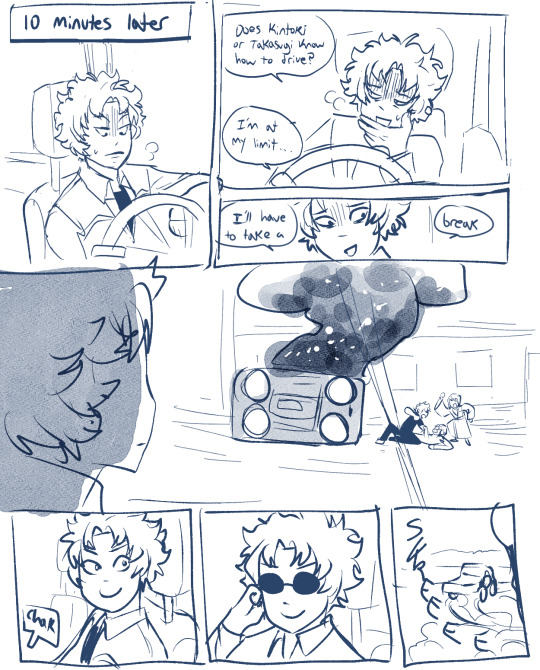




i dont like how my old gintama art looks but my absolute immortal favourite is this shoka sonjuku teen modern AU i drew in a fog when I was first watching gintama. the hair comic is the first time I drew the 80 face that permeates my art now
216 notes
·
View notes
Text
So Takasugi and Gintoki don’t talk to each other a lot throughout the story of Gintama. In fact, after they meet in episode twenty something, they do not exchange words till their final showdown 300 ish episodes later. (Other than like, Gintoki shouting at him in Benizakura.) Which is insane to me, because they feel like they’re in constant conversation with each other. And by that final showdown, they had become my favorite character foils in all of fiction.
It’s interesting to me how Gintama develops their relationship without making them share scenes. Whenever Takasugi shows up at the end of an arc to reveal he was involved in some way, you can be sure that the story is trying to say something about how Gintoki and Takasugi differ. And also how they’re the same. It allows both of them to react to the thematic messaging of each arc in interesting ways. A lot of the time Takasugi’s not just looking to pull strings, but to find other villains who would be sympathetic to his cause. And that gives us insight into what his deal is. As the arc explores each villain’s theme, we can see how much Takasugi agrees or disagrees with them. Like, Takasugi really seems to dislike Ito. He thinks he’s foolish, and Gintoki (thematically) agrees. But he likes and respects Isaburo, even calling him -dono. Even though, superficially, Isaburo is old guard in the government Takasugi is trying to destroy. They should be opposed, but they’re not.
Takasugi barely gets any scenes, but the ones he does get are dense and meaningful. And Gintoki engages with the plot of each arc in equally meaningful ways. Where that meaning overlaps is where these characters become amazing foils for each other. It makes you excited to see what happened to make the two of them become such different people. Especially since we know they stemmed from the same moral source, and fought alongside each other once.
38 notes
·
View notes
Text






Why deny us this moment, The Final, WHYYYYYY?!!!!!!!!
#gintama#gintama spoilers#why spent a whole ova on the gorilla whyyyyyyyy#why deny us 'we're your Yorozuya'?!!#(ಥ﹏ಥ)#we're your Yorozuya
16 notes
·
View notes
Text
top 5 gintama foreshadowings:
#5: all the fucking crows in light infection era gintoki backstory
#4: kamui mention in like ep 40 i guess
#3: hasegawa being the only one that doesn’t make gintoki go on a date with him in scandal arc second episode
#2: episode 27 summarizing the entire shouyou sensei plot by proxy
#1: ketsuno ana divorce being built up for 100 episodes
#chitra.txt#gintama#gintama spoilers#tho out of context its not much#anyway fuck altana this is where its at
60 notes
·
View notes
Text


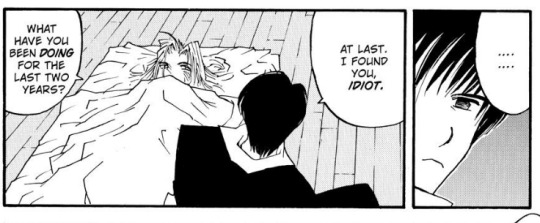

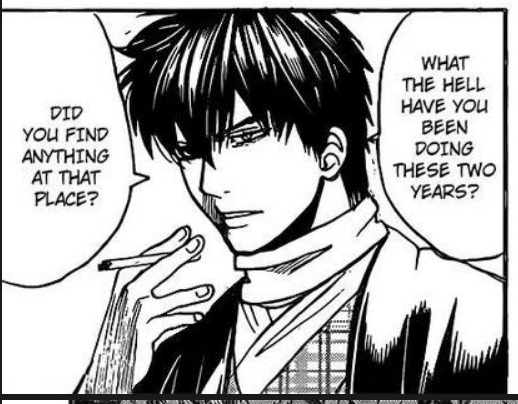
Gintama & Trigun parallels - spoilers below


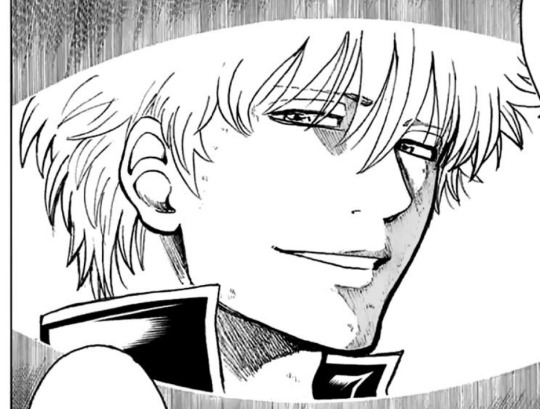
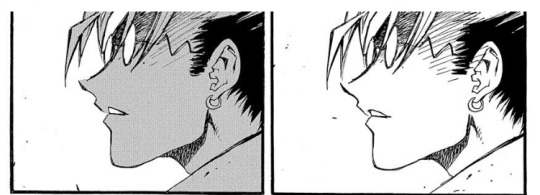




#trigun#trigun maximum#trimax#trigun spoilers#vash the stampede#nicolas d wolfwood#gintama#sakata gintoki#gintama spoilers#hijikata toushirou#takasugi shinsuke#the reason for this is i'm kind of obsessed with gintoki and vash right now
68 notes
·
View notes
Text
My Orochi Stood Up: A Draconic Response to "eat shit and die"
tshirt3000’s seminal essay, “eat shit and die,” illuminates the fact that in any sillyserious discussion of Gintama, there is a recurring tension–or overlap, or slippage, or push-and-pull–between the motif of the anus and the motif of the phallus. Far from being contradictory, however, this dynamic conceptual tug of war has the potential to be not only meaning-generating, but fundamental to a thematic understanding of Gintama. In this essay, I aim to illustrate how applying a certain homebrewed framework of mine can help make sense of these interwoven concepts and provide symbolic structure to their analysis. I’m talking, of course, about the ouroboros–also known as the snake eating its own tail.
As we all know, Gintama is full of phalluses. The sword is basically a matryoshka doll of motifs all on its own (or, to invoke tshirt invoking Barthes, the beginning of a chain of images, or significants). But the same vulgar toilet humour that leads to Gintama being chock full of dick jokes (and balls jokes, which for many reasons can be conflated with dick jokes, a primary one being that the Neo Armstrong Jet Cyclone Armstrong Cannon, practically a mascot of Gintama in its own right, stands strong, beautiful, and trinitas) also leads to plenty of hole jokes. Guys like Sorachi thinks it’s funny when the protagonist gets something stuck in his butt, or when gay sex exists, or when a guy is a sub. But there’s no need to discuss this part in depth–just read tshirt’s essay.
There’s a saying among my friend group: “all there is in Gintama is head and hole.”
Why do the sages say this? First of all because it’s funny. Second of all because it’s true. You can reduce everything in Gintama to essentially two things. Shouyou and Utsuro. Gintoki and Takasugi. Humans and monsters. Those who swing the sword right and those who swing it wrong. Those who take in and those who are taken in. Those who keep struggling and those who don’t. And then you can also always reduce these two things to one thing: Shouyou/Utsuro are, after all, the same being, even if they’re not; Gintoki; simply people, Gintoki once more; Gintoki yet again; and struggling itself. Because losing is part of struggling too. You can’t pick yourself back up if you never lost in the first place. We know that Gintoki has managed to become “a splendid human” by the end of the series–so what was he before that? Was he really a monster? At what exact point in the series did he become human? Was it while he was on-screen, while we were looking, but without us noticing? Was it off-screen, while we were flipping the page, or in the space between the panels? The answer, of course, is that he was learning to be human every day of his life, and if you were to assign him a static, general status to put on a wiki profile under ‘“species”, it would be: “becoming human.” And so “which one is the head and which one is the hole?” is the wrong question. Even if you assigned one to each half and managed not to be wrong, since they’re collapsible into one anyway, they’ll always be both.
In my ouroboros collage, I used western alchemy to stylize this struggle. This forging of the soul into a precious metal, language used by Gintama itself. Chrysopoeia–the making of gold. Or silver, as it were. But the ouroboros isn’t just a major symbol of alchemy. I chose it because, simply put, it’s the It girl. It does it all. It’s a snake. It’s a dragon. It circles the world. It represents eternity. It’s a loop. And while the ouroboros, alchemically, is a western symbol, the snake eating its tail is not. As I noted in my collage, the ouroboros and the world serpent are images that appear in traditions around the world.
I’m going to state the obvious: yes, the snake eating its own tail is the head and the hole. After all, the snake eating its own is also a symbol of fertility: the snake’s tail is phallic, its mouth yonic. Male and female, yin and yang–these are all things the ouroboros represents, because it ultimately embodies the cosmological interplay of complementary forces necessary to sustain a truly endless cycle. Now, tshirt’s essay could not be more clearly about the anus most specifically. But in this essay? Love is love, hole is hole. Sorry tshirt.
In all sillyseriousness, as tshirt details in their essay, the anus “following hocquenghem, normally stands in for the individuating function which itself gives root to desiring within the social sexual system, and the means by which we might therefore transcend the phallus.” Note the term “individuating function.” In my ouroboros collage, I included the following idea from philosopher Bernard Stiegler about the individuation process: “The I is essentially a process, not a state, and this process is an in-dividuation — it is a process of psychic individuation. It is the tendency to become one, that is, to become indivisible.” Indeed, Carl Jung (yes, that Jung) saw the ouroboros as the ultimate symbol of the “paradox” at the heart of the individuation process. Many of the lines in the second half of my poem are from him. Specifically, they’re from this one key paragraph from his Collected Works, vol. 14:
The alchemists, who in their own way knew more about the nature of the individuation process than we moderns do, expressed this paradox through the symbol of the Ouroboros, the snake that eats its own tail. The Ouroboros has been said to have a meaning of infinity or wholeness. In the age-old image of the Ouroboros lies the thought of devouring oneself and turning oneself into a circulatory process, for it was clear to the more astute alchemists that the prima materia of the art was man himself. The Ouroboros is a dramatic symbol for the integration and assimilation of the opposite, i.e. of the shadow. This 'feedback' process is at the same time a symbol of immortality since it is said of the Ouroboros that he slays himself and brings himself to life, fertilizes himself, and gives birth to himself. He symbolizes the One, who proceeds from the clash of opposites, and he, therefore, constitutes the secret of the prima materia which ... unquestionably stems from man's unconscious.
I believe the relevance of these quotes to Gintama is clear at this point. Because as I said, everything in Gintama is reducible to two opposing forces, which is then reducible to one. The ouroboros fundamentally embodies the paradox of Two, Yet One. And through the style and language of alchemy, it turns this paradox into the preeminent human endeavour, the Great Work of human existence. tshirt’s identification of Gintoki as “a reluctant hole” (very queer I agree) positions him perfectly here as the poor, tragic hero who, despite everything, Is Doing It–who is both recipient and victim of his own wisdom about the undertaking he must choose to embark on. It is a task that will last forever, even after he’s already succeeded. (In Gintama, therefore, to be a reluctant hole can denote both a noun and a verb.) And yet, there can be traced a definite “before” and “after.” In its literal shapes and features, the ouroboros forms an imperfect circle–it is a cyclical figure that necessarily depicts a break in the cycle, where mouth meets tail, where there must be an opening. A gap that must despite the snake’s best efforts exist, because a mouth is not a tail at the end of the day. Something that may seem like an insignificant smudge in the great flow of time, but that was nonetheless enough to shatter Utsuro’s “eternity.”

Though in some depictions, including the most iconic one, you can see the gap full well. Look. Does it seem like it’s smiling to you?
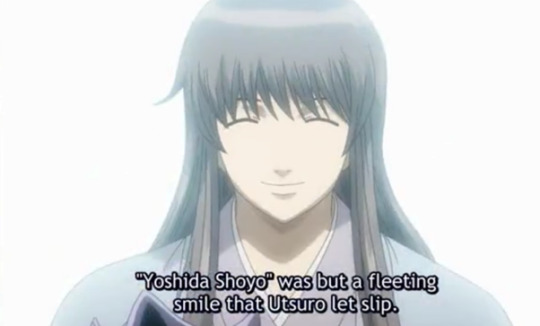
(We know Shouyou smiled right before he died–do you think that severed head of his still held a smile?)
There are a lot of other things I could say about hole. Like a hole being a sort of lack, something to be filled–a void, perhaps, one that gets artificially filled with all kinds of detritus as part of the process of person-making in Gintama. Or I could say something about the displacement or potential conflation of one kind of hole with another when your protagonist is male, cis, virile (alleged), and obviously straight in a way that makes anal sex jokes funny, and PIV jokes only too racy for Jump. Alas, this isn’t an essay on Gintama hole theory, so while there’s still much to be said about head and hole, I think it’s time we move on to one of the most important elements of the ouroboros thesis:
The dragon.
Now, the terms ryuumyaku and ryuuketsu were not invented by Gintama. As mentioned in my annotation part one (I now understand why Final Fantasy XV gave out crucial information about its story in disparate chunks spread across multiple mediums instead of behaving normally), the concept of “dragon veins” is part of real life Japanese traditions, and is tied to feng shui. The idea of concentrated life energy, or natural power, flowing through the earth along certain paths, like ley lines, is a rather common one across the world, and thus a basic building block of fantasy worlds. In my poem I highlight the geo-somatic aspect of this, how it conflates Utsuro with the planet that birthed him, effectively turning him into a world snake that walks on two feet. The tendrils of his re-knitting flesh resemble strands of hair, or perhaps the whiskers on a dragon, his blood is a river is Altana is precious oil to be extracted and hoarded by intergalactic powers, his heart is a deep, blood-red stone that denies that his blood was ever liquid, and smoke rises from him when he regenerates as though the fire that Shouyou’s body was thrown into was never truly put out.
What’s notable, though, is the person who delivers the line that draws these comparisons most concretely:

Yes, I’m cannibalizing part 2 of my annotation here. Very sad. But I’ve always said I wished Gintama had more cannibalism. So let’s press on.
Umibouzu is uniquely positioned to make this observation here because he’s the only character to have fought… well, to have come into, shall we say, “fighting range,” with both of the series’ immortals. And as uninteresting as he may be as an individual character, it’s through him that we finally gain access to a straight-on view of Kouka–specifically, Kouka on Rakuyou, before she left her planet to die femininely.
I won’t rehash too much of what I’ve already said in my collage and annotation. The Orochi on Kouan is a world snake much like the blurry dragon-vein-Utsuro-Shouyou package on Earth: a serpent with innumerable heads, both singular and plural, this time in a more literal way than Utsuro’s multiple selves or the image of a river flowing into countless streams. It’s wrapped all around planet Kouan like… well, a world snake. Or… a world tree. Because as much as it’s clearly a serpent of the Orochi archetype, it’s described in both animalistic and vegetative language (e.g., it has “roots” that spread into the planet’s core, where they soak up the Altana… but the planet is its “nest”). Kouan’s dragon is thus a mutated beast that defies easy categorization, part mythical symbol, part serpent, part plant. Kouan, after all, is no longer capable of supporting normal life, its atmosphere and soil too toxic for anything but mutants. The Orochi, then, is an animated, aberrant substitution for the Lifestream, one whose roots have replaced the planet’s veins, one that can express aggressiveness and loneliness, and whose fleshy corporeality allows Umibouzu to…
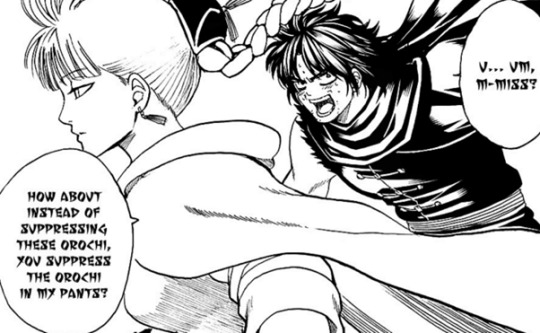
…make a bad dick joke. Naturally.
Kouka and the Orochi aren’t conflated the way that Utsuro and the dragon veins are. The Orochi is not her body: being its own creature, it appears much more separate from her than the formless glowing green Sephiroth energy does from Utsuro. But interestingly, they are mistaken for each other through the title of “Master of Kouan,” which the Orochi acts as a decoy for before the story “reveals” that it refers to Kouka. And Sorachi makes clear: the Orochi is lonely. The planet is lonely. Kouka is lonely. The Yato are lonely.
Rabbits can die of loneliness, you know, etc. etc. And as Kagura delivers to us early on in the series, the only way out of this endlessly repeating, and yet endlessly diminishing (sort of like reverse infinite tumblr chocolate) cycle, is to change.
Umibouzu’s dick jokes return us to the self-explanatory phallic-ness of the snake. I don’t think I need to explain the overlap between snakes and dragons, especially in an Asian context. So if Umibouzu is the phallus–the new arrival that introduces change to planet Kouan–then does that make Kouka the hole? Well, yes, but no. Because Kouka is the one associated with the Orochi. Kouka is the immortal, living her life frozen in time until she decides to leave the dragon behind. And in the end, when Umibouzu convinces her to leave with him, he tells her: “You and I are the same. No matter how busy a planet I’m on, no matter how surrounded by people I am. Without you, I’m lonely.” A hole, as we said earlier, is a type of lack. And neither Kouka nor Umibouzu at this point have dirt that can fill that lack–the dirt that, as tshirt put it, “marks the permanence of one’s relationships.” Because only dirt can stick enough, can stain enough to leave an imprint.
Now, in another world where Sorachi isn’t a coward and a boring misogynist, here is where I would be digging into juicy insights into Shouyou|Utsuro’s milfhood, the genderisms of being an Altana immortal, the obvious implications of Umibouzu having been a failed parent unable to deal with Kamui’s situation due to living in the same (shall we say, hole-sided) world as Kamui, which loops back around to Kamui inheriting eldest daughter female hysteria his body isn’t capable of processing a la Oboro, and Kouka’s relationship to the phallus-as-transmissive-samurai-spirit–but given that we sadly don’t live in that better world, there isn’t much I can add to this enumeration that wouldn’t be self-evident.
As an aside, it does have to be said: the nature of the snake swallowing its own tail as a simultaneously self-fellating symbol and an established motif of macrocosmic heterosexual (re)creation of the universe perfectly encapsulates Gintama’s relationship to sexual jokes and the linkages it creates using vulgar wordplay. And it’s also the sort of thing my friend tshirt would love to quote Freud on. Another way of looking at it is that the microcosm of the universe in Gintama is a queer human, who is probably a pervert. Which seems glaringly obvious when you think about it outside of the context of this essay for two seconds.
Anyway, as Jung said, the ouroboros is not just self-sustaining, but self-fertilizing. Or perhaps self-sustaining is a potentially misleading term, because by nature it cannot remain static. It can only slay itself, and give birth to itself once more. Utsuro was never the same person twice. But what does it mean to be self-fertilizing? It means, above anything else, that in the end people give hope to themselves. That Shouyou put in the work, and that what Shouyou gave birth to was, in essence, the same as himself.


An endlessly replicating chain of Shounen Determination.
Of course, this goes both ways as well.
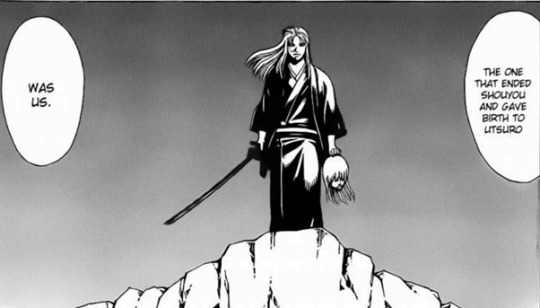
Shouka Sonjuku, then, is the embodiment of Shouyou’s self-fertilization–a motif taken up by Gintoki, our illustrious shounen protagonist enacting the genre-typical inspire and change everyone you touch. At the same time–or, you could say, anachronistically–Gintoki is enacting his own self-fertilization, fertilizing his own soul–or tama, or egg–with pieces of everybody that touches him. Because, though the hole is a lack, it is simultaneously where the crux of this self-transformation takes place. As tshirt puts it so succinctly, “the anus—the dirty human things—is the home for the phallus—the ideals we hold, the source of our power.” The scabbard for the sword of one’s soul, so to speak, but that metal for that sword is made up of fragments from many sources–as the Rakuyou arc anime illustrated for us so memorably.
In the Shinsengumi Crisis arc, Kondou (whose status as butt monkey for the crassest of Gintama’s jokes positions him in a unique way for these things) says something similar: nobody is being dyed in another’s colour. It’s hard to even say what colour other people’s souls really are, if everyone’s soul is made up of broken off bits and shards and dead things (positive) from all over the place, like beach sand. What Itto has mistaken as a form of influence over others, as the level of dominance of one’s soul, is really just:
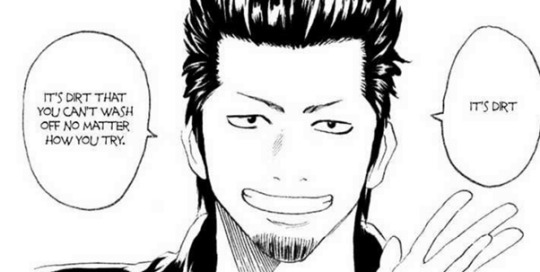
“Because it’s something annoying that you can’t get rid of, in the end it becomes troublesome when you start to care about it.” Or something like that. The translation here is probably at least a little suspect, but you get the gist of it. tshirt’s analysis of gorillahood is potentially interesting and relevant here as well, but I’m afraid I have to move on for the sake of keeping things on track.
It’s worth noting that even as, from Gintoki’s perspective, Shouyou smiled at him right before he died, from Shouyou’s perspective (and of course, from Takasugi’s)–Gintoki smiled back.
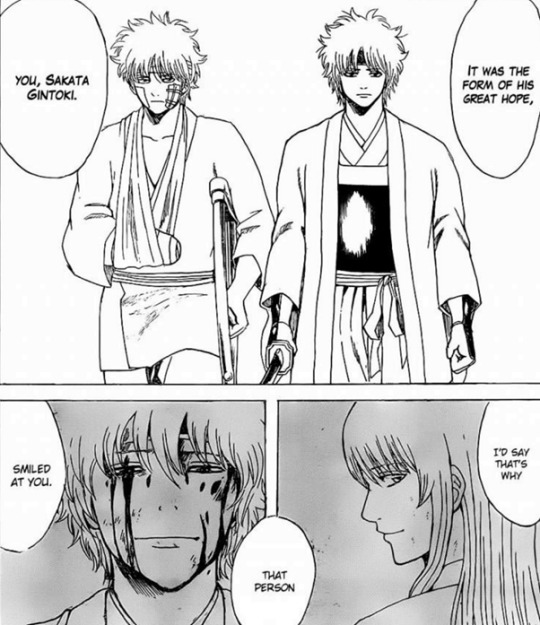
Incidentally, the chapter two chapters before this one was named “The Two Utsuros.” Later on in this scene, Sakamoto refers to “the two Yoshida Shouyous.” And on this page, we see two Gintokis. Isn’t Gintama fun?
What of Kouka, then? I think her situation is clear. She created literal children of the flesh rather than of the spirit–and there is unfortunately little else to say, because even this is quite obviously a cliche of the dead anime mom. The context of Gintama’s story is enough for us to assume an implication of her having transmitted something to her children, of them carrying on her legacy in some way… but her character is too woefully undeveloped for me to say anything particularly interesting about that. What little I can say is essentially what I depicted in my annotations. When Umibouzu wants to whisk her away from Kouan, Kouka asks him–why did you remind me of these emotions? At the end of Silver Soul, it becomes clear that Utsuro’s professed “void” is not so empty after all–just like Kouka, he had simply been denying that he felt anything that ran contrary to his driving force, i.e. the power of his great resignation (“eat shit and die” terminology intended). For a long time, Kouka was resigned to staying on her planet–on her dragon–as its heads multiplied. In the end, she chooses to leave the planet behind, willingly sundering her eternity, and the planet watches her go. She dies because she became alive–just like Shouyou. It’s also worth noting that, when Kouka initially tries to disappear from Umibouzu, it’s the Orochi that points Umibouzu to her location, blending them into a sort of phallic comrade-in-arms, even as the Orochi is, as I said earlier, attached to Kouka’s existence. So in this ouroboros reading, Umibouzu simply becomes a device for her self-fertilization. Yayyyyy.
Here we can see the relevance of wordplay and dick jokes to any sillyserious analysis of Gintama. The motif of self-fertilization, in particular, is a rich arena for the conflation of sex and shit that tshirt notes is enabled by Gintama’s beloved [BLEEP]: “connected by dirty things can implicitly stand in for shit, sex, or the penis itself.” In the ouroboros framework, both sex and shit ultimately denote that which gives birth to others and that which gives birth to yourself. Your legacy is made of the same stuff as you, is you, and you are finally brought into being by your legacy, in a process that transcends linear time. The ouroboros is literally connected to itself by its own tail–or head, depending on how you look at it. It’s all one snake, after all. I suppose you could say this is one reading in which Takasugi’s ambiguously alive-yet-dead state at the end of the series makes sense–he was always a shadow that could be folded inside Gintoki’s body. But I don’t like it, so it’s actually very bad.
In any case, the procreation of the universe, yourself, and other people happens interdependently and simultaneously, yet something has to happen first. It’s a chicken-or-egg scenario, an endless cycle that needs an initiating key moment–or, to be Utena-esque for a moment, a shell-cracking moment–for life to exist. If Utsuro’s eternity was an egg, then the moment of Shouyou’s birth as a human, itself undefinable in time, was what cracked it (Utsuro egg cracking moment). Of course, I think all Gintama fans innately understand that the moment of Shouyou’s beheading is the single most pivotal moment in the series. But after speaking of head and hole for so long, I think it’s finally time to address the obvious:
Gintama is about severed heads. A lot of them. (Shoutout to oomf’s severed head collection.)
The importance of beheading as a motif throughout the series interacts in a very interesting way with the ouroboros thesis. Some heads in Gintama need to be cut off. Others resolutely need to stay on. But even for the ones that need to be severed, it needs to be done right–or watch out. Or, as I once said:
“gintama is like. sometimes people die when they are killed. but this is not guaranteed. and sometimes people survive because they are killed. among the cast are people who need to die and people who need to survive. choose wisely” (me, 2022)
Within the stylized aesthetic framework of the ouroboros, this is where the metaphor of the hydra becomes useful. Cut off one head, and two more will sprout in its place. If you don’t swing the executioner’s blade right, the monster will remain a monster–or grow even more monstrous. Even worse, you will have failed to possess a human’s heart while swinging that blade–so what does that make you? Failing at being human in relation to the sword, then, puts you in danger of falling into the neurotic failure state described by Freud described by Hocquenghem described by tshirt.
Gintoki didn’t fail, though. He just wasn’t able to succeed yet, without the rest of his story having unfolded yet. And so, within that paradoxical instant, the very heart of the ouroboros, Shouyou was saved and Utsuro was born. There is a persistent, and I would argue intentional, analytical ambiguity to this moment unless you allow for the paradox within it, represented by the moment of duplication where Sorachi likens Gintoki to Utsuro and presents both as the “one” wielding the sword. If Gintoki killed Shouyou with a human’s blade, then why was Utsuro born? If Utsuro killed Shouyou with a monster’s sword, then how did Shouyou’s humanity crystallize? If Gintoki became human throughout the course of Gintama, then how did he possess a human’s sword ten years ago? If he didn’t have a human’s sword and do the right thing back then–how could he have been the bottomless mirror standing unbreakable and infinitely reflective in front of Takasugi, Hijikata, Kamui, Nobume, and so many others?
Diegetically, of course, the answer is that Gintoki simply did the best he could, lost everything, and then picked himself back up and un-lost everything. Shouyou, too, just lost to Utsuro, because he was a human, and humans lose all the time, no matter how wise and gnc they might be. But he came back; or he survived; or the world survived without him–it doesn’t matter. Of course, I don’t believe Gintama is a series where you can really separate the “diegetic” from anything else (if you tried to explain anything that happened in it that way, the result would be not only very dull but hardly accurate). In a blend of shounen inspirational metaphor and absurdity, the series’ main themes are simply delivered through the mouths of various characters, without care for either subtlety or compromise. This is, after all, the series where our protagonist was given strength to keep going through a little girl telling him, don’t worry, mister, when I grow up I’ll become a splendid executioner and cut your head off for you! You could say that Gintama is full of a sort of “head anxiety” that only Gintoki is aware of. Oh man, I cut my teacher’s head off. Oh man, what if I did it wrong, that was so scary. What about my head, is my head weird? I bet it’s weird. Is it coming off? Is it stuck on too tight? Is this normal? Is my head too small for my body? Man, I can’t show people this. When is it coming off? Asaemon’s words also link the promise of death with the promise of life, or redemption–he must live so that he might die, and it’s only through death that he can truly live. Very ouroboros-esque.
One thing I’d like to point out here is that Gintoki was imprisoned after Shouyou’s death. He hears Yaemon’s crucial, This Is A Surprise Tool That Will Help Us Later speech about beheading only after he’s already gone and beheaded someone. This is both straightforward foreshadowing and also unintentionally funny. But what I’m going to argue here is this: the fact that the Reaper Arc comes before Shogun Assassination for us makes it true enough for Gintoki as well. Because the moment Gintoki sliced Shouyou’s head off was the moment Shouyou’s humanity was affirmed, and thus the moment Utsuro’s “eternity” could be confirmed to have shattered. At the same time, it’s the moment of Utsuro’s birth into the world. In other words, it’s where the ouroboros ends and where it begins–a moment isolated in time and space, located, if anywhere, in the time of monsters. And this is mimicked by the Gintama narrative itself, as Shogun Assassination marks the end of the structure the entire series existed in prior. A two-year timeskip would never have been possible previously, as the series’ time circled on in endless loops, one anniversary after another, one Christmas season after another, without the characters ever aging, even as they grew wiser. The moment of Gintoki’s tragedy, finally fished out from within Takasugi’s eye, shattered Gintama’s “eternity,” too.
I’ve already gone and used the hydra, so I’m going to be exceptionally silly here and invoke another piece of ancient Greek mythology, as a homage to hole and to Gintama’s dedication to bad puns: Uranus. According to Hesiod’s account of Aphrodite’s birth, when Uranus’ balls were cut off by his son, the goddess emerged from the white foam that flowed into the sea. You might be asking, am I really going to compare ball removal to decapitation? (This is a rhetorical question. No true Gintama fan would question this.) As I hinted at earlier, Gintama itself already provides the grounds for this kind of comparison through its ideological commitment to balls. It is, after all, Gintama. Phallic or yonic is largely irrelevant here, as this isn’t really about castration (sorry tshirt). Instead I want to emphasize the “head” in this case being the symbolic object imbued with transmissive and procreative power. This interpretation is, in the spirit of Gintama itself, built on playful punning between tama (ball) and atama (head). In the series, Shouyou and Gintoki are the characters who embody the relationship between microcosm and macrocosm most substantially–with Utsuro’s geo-somatic embodiment of Earth juxtaposed with his dominion over the forces of space, while of course also being the premier “dragon” of the series; and Gintoki enfolding the entire story within himself, both the silly and the sad. And so when Gintoki cut off Shouyou’s head, it was the birth of a universe, the “seed” spilling out from that severed neck and setting in motion the story we know and love.
(Incidentally, the magic sci-fi spark that gives Tama, who ended her introductory arc as a severed head in Otose’s snackhouse, the ability to be human is called “the Seed.” Did you know that Fuyou means lotus?)

(I just thought that was interesting.)
Incidentally, while Japanese mythology sadly doesn’t feature any testicular cosmology, it does offer a rather interesting tidbit. According to the Kojiki, Izanagi and Izanami were tasked by the other deities to create land together using the heavenly spear Amenonuhoko. This is described thus:
Granting to them a heavenly jewelled spear, they [thus] deigned to charge them. So the two Deities, standing upon the Floating Bridge of Heaven, pushed down the jewelled spear and stirred with it, whereupon, when they had stiffed the brine till it went curdle-curdle, and drew [the spear] up, the brine that dripped down from the end of the spear was piled up and became an island. This is the Island of Onogoro.
…I think this account speaks for itself. The island of Onogoro became the first piece of Japan (and thus the world), formed out of briny white water, reminiscent of the white foam that Aphrodite sprang out of. Izanagi and Izanami then erected a pillar on the island and built a palace around it, then moved in and started making children. There’s more I could say about Izanagi and Izanami in relation to the ouroboros, but I think that would be too much of a digression. In any case, it takes little effort to imagine why multiple peoples long ago might have looked at sea brine and seen in it an intuitive symbol for creation and genesis–especially a people for whom the sea was a literal source of life. But what I’d really like to draw your attention to is the translator’s footnote on the translation of “jewelled spear”:
The characters translated “jewelled spear” are [], whose proper Chinese signification would be quite different. But the first of the two almost certainly stands phonetically for [] or [],—the syllable nu, which is its sound, having apparently been an ancient word for "jewel" or "head," the better-known Japanese term being tama. (Unfortunately, the characters can't be displayed.)
And there you have it. Is a “spear” really that different from a sword when you think about it, especially when it’s a spear carrying that kind of symbolism? Or, as tshirt put it, “the pole and the hole.” And I’d like to remind you that Utsuro’s body is likened to the land of Japan itself through the very-much-Japanese concept of ryuumyaku, not just my own artistic derangements. His blood is the life-bringing sea, his flesh the earth of the archipelago. When he fell back into the mouth of the earth at the end of Silver Soul, he was falling back into his own mouth, the serpent devouring itself once again.
Unfortunately for Utsuro, within the confines of this essay the mouth is akin to the asshole. Hole is hole: this I did solemnly swear to you at the start of this essay, and I intend to uphold my vow. Utsuro, then, falls back into Hole, and the earth spits him back out–hydra head clumsily cut off, having sprouted into two once more. You could compare, perhaps, Shouyou only re-emerging after having been thrown back into the dragon vein and shaken around a bit to Gintoki’s soul’s own instinct to fly towards buttholes when knocked out of its proper container. In the bodyswap arc, Gintoki gets hit by a truck and sadly survives, though his soul is shaken loose and part of it breaks off (no wonder, when it’s made up of so many little bits), and ends up entering the asshole of a dead cat. Gintoki is essentially a dead-eyed catboy, so this is an easy mistake to make. Additionally, in one of the most memorable gags of the final arc, Gintoki gets swallowed by Sadaharu and pooped back out, but missing two-thirds of his body that, again, accidentally came apart from him while he was in there. They need to be recombined in Sadaharu’s guts, which through his connection to Altana as an inugami constitutes a makeshift dragon hole, until Gintoki finally exits hale and whole from his dog’s asshole.
What did he mean by this?
Well, first of all, it seems like you have to be gentle with Gintoki, despite appearances. He’s made up of so many bits and pieces and people that parts of himself will break off without him even noticing. Second, these gags link the idea of plurality to dirt to the anus as the site of the reconstitution of the self. Or, as Jung said, the “integration and assimilation of the opposite, i.e. of the shadow.” Gintoki’s shadow can be represented by Takasugi. Or it can be represented by a naked, hyper-muscular Hello Kitty monster made up of his memories of war and his gambling addiction. They’re both missing an eye and have PTSD, so close enough. What’s fun is that in the Sadaharu gag, the punchline, “Gin San,” is about Gintoki’s name–the “Gin-san” identity he must take on once more to be able to face Shinpachi and Kagura. The joke faintly echoes the tonally very different scene on Rakuyou, where Gintoki told Kamui that Kagura and the others filled his emptiness, giving him the new name of “Gin-chan.” Asaemon, of course, also echoes parts of this, as her primary narrative role is to not-so-subtly provide guidance for the reader to understand and resolve Gintoki’s thematic journey, a parallel made more digestible through her distance from Gintoki as a feminine, vulnerable, indecisive character whose past is totally illuminated to us. At the end of her arc, she kills herself, and gives birth to her new self, like any healthy Gintama character.
Indeed, Gintama’s moral is to “fight yourself,” so naturally all the characters who haven’t given up yet are constantly in the process of devouring themselves. But this is a different process than emptying yourself, which is what the antagonists are doing. All Gintama villains are hole-sided, desperately trying to destroy themselves while pretending, as hard as they can, that they don’t know that you can’t destroy a hole–only make it bigger. I emptied myself on purpose, Kamui insists. I did it intentionally and edgily, so it’s different and your criticism is void. He truly is an 18 year-old boy. Kamui and Takasugi were unable to accept themselves as the ultimate fruit of Kouka and Shouyou’s transformations–their magnum opus. It’s interesting that in their very last snapshots, both of them are bodily changed, taking on younger forms invoking a sense of renewal; Takasugi literally being pooped out of a dragon hole as an ugly infant. While I don’t subscribe to Altana immortal Takasugi theory, in a literal sense Shouyou died and Takasugi was reborn–or, to be more precise, Shouyou returned to the macrocosm, to the lands and grasses and waters of the dragon’s earthly body, and Takasugi re-emerged in his micro (short joke) place. After all, the ouroboros always gives birth to itself, and Takasugi was never expelled. He has always been a part of Shouyou. As Sakamoto said, it’s only natural.
As for Kamui… I originally had a section here discussing his case, centered on his tag-team battle with Kagura against the Eldest, that one-off Silver Soul villain who is first presented to us almost like a strange, low-budget imitation of Utsuro.

However, as much as this guy does end up being a living dick and balls joke, I’ve decided to reserve this material for a future essay where I can delve into the question of blood more fully. So consider this a teaser. This essay has gone on long enough, I think.
So what can we conclude from it? As tshirt observes, Sorachi cannot resist the phallus (or the balls), even beyond the obvious “sword” metaphor. Viewed from the lens of the ouroboros framework, however, Gintama’s insistence on wordplay enables interesting meaning to be derived from these dirty jokes and their interaction with other motifs in the story. After all, the name of the series itself elevates the spirit of the balls joke, even if unintentionally, to the same level as the other metaphor in the title: “silver.” In “eat shit and die,” tshirt notes the important role that conflation plays in both Gintama’s humour and meaning-making, a role we’ve seen repeatedly in this essay with the purposeful blurring of person and dragon and planet, and its deliberate use of paralleled “other selves.”
But perhaps the singularly most important example is the -tama in Gintama, with its plethora of potential meanings, each of them just silly and dirty enough that you have to take it seriously. Beyond the obvious joke on kintama (balls) and the “silver soul” meaning (which the series could not be more explicit about), we’ve seen that tama is also easily conflated with atama (head), and even with tamago (egg). This is clearly demonstrated with the series’ fixation on beheading leading to the salvation of the soul and the bodyswap arc hinging on the pun between soul and egg, which English translators very impressively retained using “egg” and “ego.” The fact that the characters end up turning into giant turds, likening the soul-egg-balls to an asshole, only drives the point in further. In this essay, I took things one step further in mapping these different motifs onto the phallic and yonic/anal (the holeic, if you will). After all, the tension between the phallic and the anal is fundamental to the ouroboros’ symbolism. It is this tension, and this complementarity, that leads to both destruction and creation, death and renewal. One of the reasons I chose the ouroboros as my stylization of choice is that Gintama perfectly encapsulates that central concept of death as rebirth–while throwing in the seemingly contradictory case of the main villain, who is very much Rebirth, But Bad. The ouroboros, then, supplies the symbolic technology to convert the inherent contradictions and sometimes difficult to navigate ambiguities of Gintama’s thematic structure into a more legible, metaphorically potent form.
As I noted in the beginning of this essay, every character in Gintama is ultimately both head and hole, both the beginning and end of the serpent, as the two belong to a single entity. If the head demands the cold bite of the executioner’s sword, the void inside of people also needs to be filled with the essence of others before they can be properly human. You can’t behead yourself–you need someone else to swing the blade. And yet that person is also, in some way, you. The one restoring you to humanity is yourself, the one slaying you is yourself, the one you give birth to is ultimately yourself.
The serpent eating its own tail’s self-fertilization schema is the key tying together the draconic motif of the ouroboros with the tangle of messy metaphors, tautological themes, and fraught relationships that make up Gintama. Naturally, the throughline running through it all is dirt–of the dirty joke variety, but also dirt as that which clings to others, dirt that fills, dirt that stains, dirt that, in short, remains. If the phallic is what inseminates and transmits (as the sword that releases and crystallizes, as the heavenly spear that leads to genesis), in other words tama as “balls,” then the anal is the scabbard for the sword, the vessel that receives and holds on to the seed that is dirt, the cradle where our soul is fertilized–in other words tama as “egg.” Tama as “soul,” then, is simply the combination of these things, the result of this self-fertilization: it is ourselves. When all is said and done, this is reducible to a rather simple message that Gintama has always had: you cannot make yourself alone, but that is hardly a problem or an excuse, because you are never as alone as you think you are.
Let us end on the question of Gintoki’s wooden sword, or as tshirt put it so insightfully, his “prosthetic phallus.” In the end, in Gintama all souls are artificially–yet organically–created through the process of chrysopoeia. tshirt’s argument that Gintoki’s wooden sword is made all the more transgressive for not being a “real” sword highlights the fact that even in the most surface-level reading, Gintoki’s wooden sword is more sword-like exactly because it invokes the idea of one without the technical reality. The “human’s sword” that Gintoki attains at the end of the series is airy and abstract, but more than readily understood by the reader because that is the kind of sword he’s been wielding all along.
As I noted before, even if Gintoki has become human, his task has not ended. The Great Work will continue forever, even after it’s already been accomplished. If the human is the microcosmos and the stuff inside them is, as Jung says, the prima materia, the formless base element of the universe, then it is not only the fruit but also the process itself that creates the world. And though this essay has not been about queer theory, let it be said that the profundity with which Gintama treats the act of self-transformation, along with the nuances and textures of Gintoki as a “reluctant hole,” make him a captivating protagonist on more levels than one. And of that desperate struggle to produce a human being, of the base substance inside of people that is their only natural material, let me quote the 17th century Theatricum Chemicum, on the subject of the prima materia:
They have compared the "prima materia" to everything, to male and female, to the hermaphroditic monster, to heaven and earth, to body and spirit, chaos, microcosm, and the confused mass; it contains in itself all colors and potentially all metals; there is nothing more wonderful in the world, for it begets itself, conceives itself, and gives birth to itself.
Emphasis mine.
Appendix A:
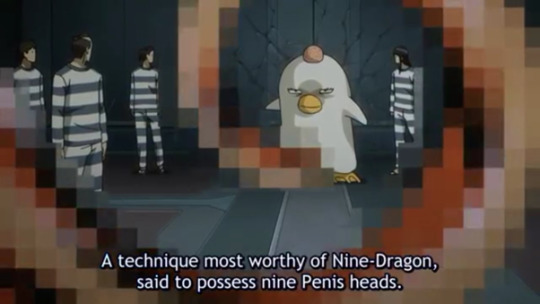
#gintama#gintama spoilers#dear god.#posting this on ginpachi-sensei anime announcement day. we are subject to cosmic forces after all
125 notes
·
View notes